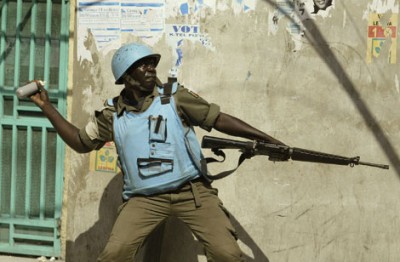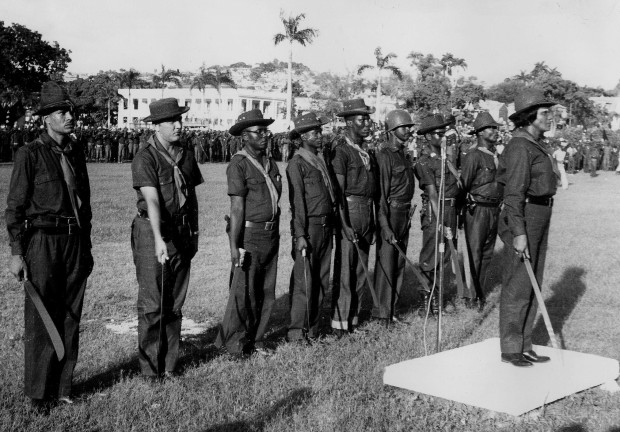Reconstitution of Haiti’s Tontons Macoutes: Trained by the U.S. and Integrated in the UN Occupation Force MINUSTAH

The peaceful territory of Haiti, which has the lowest crime rate in the Caribbean, is occupied by more than 19,627 armed personnel. Specifically, at the last count on October 31, 2014, there was a domestic force of 11,228 established police and 1,144 in training, plus a United Nations force of 4,965 “peacekeeping” troops and 2,290 police officers. This occupation force amounts to about one machine-gun toting individual for about every 500 Haitians or fewer, even without counting the ubiquitous security people who guard the businesses and homes of the rich.
A national police trained by DynCorp
In principle, there is a distinction between the personnel from the United Nations Mission for the (de)Stabilization of Haiti (MINUSTAH) and the men and women of Haitian law enforcement, because the latter presumably all reside in Haiti and are Haitian nationals who have never renounced their citizenship. In practice, however, the UN force and the increasingly foreign-trained “Haitian police” force have become quite indistinguishable. The Director General of the Haitian National Police (PNH), Godson Orélus, formally commands this domestic force and is called to answer for its actions; nevertheless it is trained by advisors from the Virginia-based United States private military and security contractor(PMSC) DynCorp, who are inserted in the UN, probably as part of its supposed “international civilian personnel” (343) or “Volunteers” (130). In April 2013, DynCorp received a $48.6 million contract from the US State Department’s Bureau of International Narcotics and Law Enforcement Affairs, for a one-year base period with three one-year options, for the insertion of its trainees into the UN police force in Haiti. On the occasion, DynCorp boasted of having already trained over 400 “Haitian police.”
From gendarmerie to FAd’H
Such a US-controlled police force was tried before in Haiti during the 1915-1934 occupation. Then a US-loyal gendarmerie, which answered directly to the US Secretary of State, was set up to replace the highly regarded national army. The gendarmes functioned like a mafia that lived from extortion; furthermore, even after the occupation, they stood ever ready to organize countless bloody coups d’état on orders from Washington. For example, General Paul Magloire’s coup against President Dumarsais Estimé in 1950 was a US-sponsored action via the gendarmerie, as was the 1991 coup against President Jean-Bertrand Aristide. The only respites from this bloody army have been its castration in the 1960s by Francois Duvalier’s Tontons Macoutes, a militia of peasants loyal only to him, and Aristide’s disbanding of the army altogether in 1995. Aristide replaced the army, by then renamed the Armed Forces of Haiti (Forces Armees d’Haiti, FAd’H), with a civilian police force, the Police Nationale d’Haiti (PNH), on the advice of Costa Rican President Oscar Arias Sánchez and after reasoning that Haiti ought not to spend 40 percent of its gross domestic product (GDP) on an army of 7,000 soldiers, even though the country has no hostile border.
Rape, murder and mayhem
In keeping with their training by MINUSTAH, or rather DynCorp via MINUSTAH, more than 600 members of the PNH (variously called BIM,CIMO, UDMO, BLT, DCPR, Politour, etc. for their specializations) have been dismissed from the force for crimes that include rape, drug trafficking, and murder, the most recent purge being in June 2014. On August 10, 2014, five PNH members organized a prison break involving 329 prisoners as a cover for an escape by the rich scion Clifford Brandt. MINUSTAH admitted that it had trained all five individuals who had taken bribes to organize Brandt’s escape.
Members of the PNH have been involved in countless arbitrary arrests, tear gas launches that have resulted in deaths, as well as deliberate killings of peaceful protestors who have opposed the government’s policies, and massacres of peasants who have objected to the theft of their lands. Opposition Senator Moise Jean Charles was nearly killed by a tear-gas canister that was launched directly at him during a protest on October 17, 2014. Subsequently, an unrepentant Godson Orélus told the Senate’s Justice and Security Committee that as long as there is “disorder”, the PNH will launch tear gas at protesters.
Haitian Senator Westner Polycarp has accused the PNH of serving as a “militia in the hands of Michel Martelly,” and there is much to support this assertion. For example, for some time, the regime has used the PNH as a place in which to hide armed personnel who could not legally police Haitian territory. In particular, the PNH is routinely supplemented on special occasions, such as protests, with Haitian-American officers from the New York and Miami police departments (NYPD and MPD).
An incubator for Tontons Macoutes
The National Network for the Defense of Human Rights (Réseau National pour la Défense des Droits Humains, RNDDH) published in an open letter dated December 17, 2014 its discovery that 38 individuals close to the executive branch, who had returned from military training inEcuador, were being sequestered in the PNH’s 25th graduating class. These named individuals, who were disguised as normal police trainees, drew attention to themselves because many could not read or write, although admission to the police force requires a junior high school education at a minimum; the great majority (32 out of 38) were 31 to 45 years old, although entry into the force is restricted to people between 18 and 30 years old, and finally, many were so arrogant and undisciplined that normally they would have been dismissed from the force, had it not been for their influential sponsors.
These paramilitary troops were hand-picked by Martelly for training in Rafael Correa‘s Ecuador, and they look very much like the kernel of a new Tontons Macoutes. Indeed they are meant to become the core of a new military force. Officially, they go by the inoffensive title of “military engineering corps,” and the regime says they are based in Artibonite, although they are hidden in the PNH. A “Defense White Paper,” to be released in July 2015, will elaborate the details of this supposed defense force for Haiti. Five workshops on the document have already been held, and Martelly’s Defense Minister Lener Renauld, who is also a former Major of the disbanded and disgraced FAd’H, seems to be very much in charge of this project. According to Renauld, the last meeting for the completion of the action plan will be “in February in Washington, at the Inter-American Defense Board” (IADB, Junta Interamericana de Defensa, part of the Organization of American States, OAS). Given the exclusion of the Haitian population from these discussions, and the extensive overlap between the member countries of OAS and MINUSTAH, this project looks like a cover for the perpetuation of MINUSTAH as a force of Tontons Macoutes loyal to Martelly.
What army for Haiti?
Clearly, Haiti needs a force that can safeguard its sovereignty and at the least prevent its democratically elected presidents from being kidnapped by foreign governments. Throughout Haitian history, the main threats to sovereignty have been invasions by large western forces and the ravages of their megalomaniac client dictators. Such attacks are best countered by a militia system like the one that existed during Toussaint L’Ouverture’s rule in 1801-1803, or the one that prevented Hitler’s army from invading Switzerland during World War II. A militia system involves arming all citizens and is, by nature, decentralized and locally controlled. As such, it cannot attack, but it presents a formidable defense. According to Stephen Halbrook:
“The reason that Switzerland was too difficult to invade—in contrast to all the other nations which Hitler conquered in a matter of weeks — was the Swiss militia system. Unlike all the other nations of Europe, which relied on a standing army, Switzerland was (and still is) defended by a universal militia.
“Every man was trained in war, had his rifle at home, was encouraged to practice frequently, and could be mobilized almost instantly. The Swiss militiaman was under orders to fight to the last bullet, and after that, with his bayonet, and after that, with his bare hands. Rather than having to defeat an army, Hitler would have had to defeat a whole people….
“The Swiss governmental system was decentralized, with the separate 26 cantons, not the federal government, having the authority. The federal government did notify the Swiss people that in case of a German invasion, any claim that there had been a Swiss surrender should be disregarded as Nazi propaganda. And because the military power was in the hands of every Swiss man, the federal government would have been unable to surrender had it ever wanted to.”
Under Toussaint’s rule, all men were required to serve in the state militia, and it was this universal militia that served Haiti so admirably at the decisive Bataille de Vertières of November 18, 1803. Such a militia system would work well again for Haiti, and it has the advantage of being the sort of project that could not involve “foreign friends.” Haiti should never again relegate its defense to a professional army. Such armies have proven again and again to be predatory. Instead, as a civic duty and for the sake of genuine stability, every Haitian man and woman should be trained to defend the territory.
Sources: Haiti Chery | Photographs one, two, three, five, and eight from UN Photo archives; photograph seven from Ansel archive.








